Rock-solid Marketing
Welcome to an incomprehensive case study on influencer marketing by yours truly. It involves a steak that’ll crack your chompers, Saudi Arabia, Indiana Jones, millions of followers, thousands of dollars, and a dirty river somewhere in southwest England.
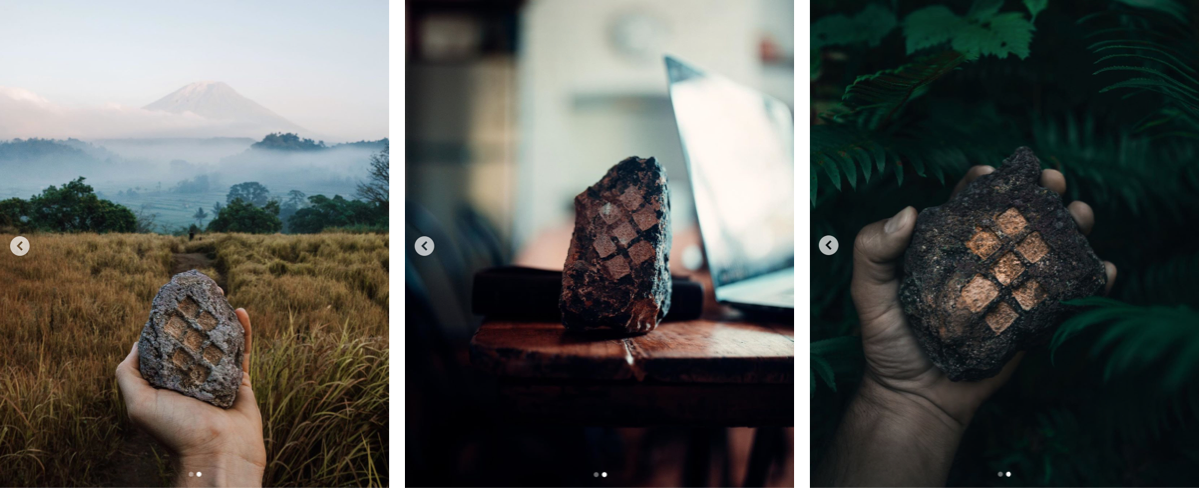
In 2019, I was working on Setapp. If you’re not familiar, it’s a SaaS product for Mac apps. I wrote a good chunk of the website, including the tagline and description right up front.
You found Setapp. The frontier platform that packs 170+ Mac apps into just one. A personally curated membership for $9.99/mo.
On the growth marketing team I was the, er, Full Stack Copywriter. The real title’s a bit different, but full stack sarcastically well-describes the breadth across which my texts covered the product.
Setapp had been around just under two years when I joined. The marketing budget was relatively huge due to funding from the company’s other, more stalwart product. We were throwing bills at people to promote Setapp, but we couldn’t get them to drip down the funnel into full membership because the product lacked real value.1
We had a lot of room for experimentation with a bubbling marketing budget. The backlog was long but made of safe tasks and one-offs. I wanted to take a risk, reaching beyond our usual door knocks and into completely new audience territory. Here’s what happened.
The Idea
At Setapp, the marketing team frequently contracted tech YouTubers to talk about how great Setapp is. This type of influencer marketing is only effective to an extent. Our audience is savvy and can see through paid promotion. In consumer nations, buyers are ever wiser about seeking authentic reviews and cutting through common advertising sewage.
My brother Kevin is inspired by travel influencers and content creators. The made-it’s of those pectoral fellows and fancified dames often promote products. But if you read the comments carefully, picking through the weeds, you can frequently spot jealous types or aspiring creators who are so damn curious about what equipment their idols are using to achieve such salivating shots. As if buying the exact camera and lens could somehow transport them to a Parisian rooftop with sideshow doves, caramel skies, Cartier watches and a pearl-toothed posse.
Eureka, bitch.
Content creation is at the core of Setapp. So is digital nomadism. Needing only your trusty Mac and a hearty imagination to get to those peculiarly clean roof cushions. I’d have those tiny, coincidental social media stars puff up Setapp.
The Pitch
Ads smell bad. We avoid them like a fart. And like a fart, it’s not always detectible when one’ll come along. So we install blockers. We click skip. We just close the damn page.
Is tasteful, authentic, thought-provoking product placement is the ideal? Or, is it the idol?
You’ve seen Indiana Jones. The one with the big rolling stone and the stout gold screaming lady. If not, pretend you have and don’t tell anyone you haven’t, then watch it.
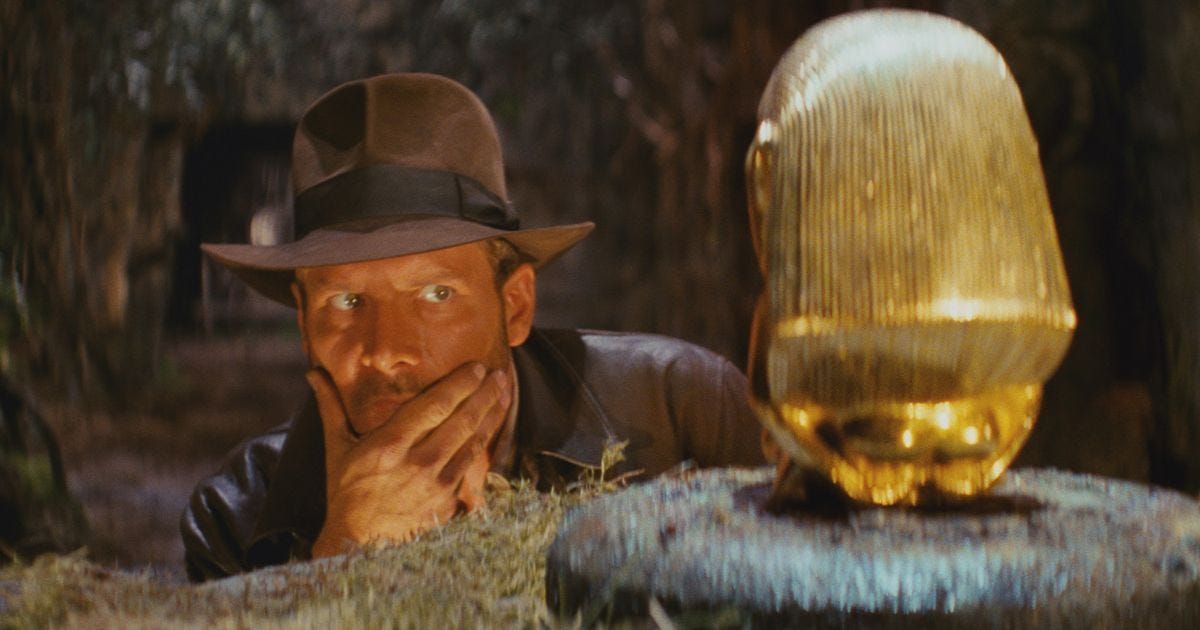
To the Setapp growth marketing and PR teams, my pitch was this. Have rocks made like little Jonesian relics with the Setapp logo. Send them out to Instagram bigshots. Remember the tagline? You found Setapp. The influencers would play it like they’d discovered the relics, then spurt on about how they use Setapp to logisticize their journeys and edit the almighty, orgasmic content. Their audiences would be mystified and not the least bit offended by the authentically-placed stones set perfectly in their Adobe-augmented natural settings.
The Strategy
To pull this off, I’d need two main things: the rocks, and the people to show off the rocks. I didn’t have a budget for this campaign, just a “tell me the cost and I’ll let you know”. Setapp’s got a dime or two for the fountain.
I spent an hour googling stone masons and emailed a few solid options with the brief. After narrowing down to three carvers intrigued by the idea, I had them send images of the type of stones they’d use. All of them were fantastic, but one fossil photograph really caught me. It drew me in.
Ben Russell, known professionally as The Dorset Stone Carver, was my man. Ben “The Rock” Russell. Benny Rockwell. B Rock. He sent me photos of moss-dripped river rocks still wet with sheen. They were as I’d imagined, found relics. He told me he’d gone on a walk with his doggo and sniffed ’em out of a stream in southwest England. These were it. I set Ben to chop-chipping straight away.
Next. The influencers. Kevin supplied me with a list of his go-to guys and gals. I must have sent around 40 emails. Some went to the camera food directly, others went to their managers. I received quotes for one Instagram post with an accompanying story that would reference-link to Setapp. Please sip some liquid. The numbers I got back will eject it forcefully from your mouth hole.
The most expensive of the bunch, for one post with story, was $125,000. Yeah.
Most ranged from $2k to $20k, which is still a yikes amount of dough. Lower price range accounts had 120k+ followers and the higher tiers were in the millions. I was more interested in engagement ratios and authentic comments and audiences.
For a first run, we went with three folks. Two of them with more than a million followers and one with a bit more than 100k. They’d have full creative control so the content would match their brand aesthetics. I’d approve the photos and the captions. They’d just have to use our UTM-loaded referral link for conversion tracking and the hashtag #youfoundsetapp.
Contraband
This part was unforeseen. Setapp is based in Kyiv, Ukraine. It’s known to be one of the most corrupted places in Europe, despite getting bits better over the years since certain revolutions that further separated the country from Russia. Bureaucracy is a pain in the booty. And getting things through customs can be tricky.
When a box of 20 paper towel-wrapped stones with mysterious symbols on them arrived at the border, they were held up. I had to troubleshoot with Ben and we had to explain the project to the border agents. Don’t try shipping your cocaine in cut rocks.
When the rocks came through, some time was lost. Influencers were traveling around as they do and had to scrap ideas about how to integrate the rocks in their feeds when they’d leave a place having expected the rock to arrive. With the help of a very patient office manager, we shipped rocks around the world to various drop points ahead of when the phone-famous figures would arrive. We often missed the delivery mark. Despite slight lost collateral, it’s romantic to think of the missing rocks floating around a shack in Switzerland or a Bali bungalow. The lost relics make the found relics far more authentic. Unplanned serendipity.
The Outcome
You’re wondering how these puppies look. These pricey posts. Scroll on.
The first of the bunch. Jack Morris lives in Indonesia and this photo was taken at his terrible office. Who’d want to work there? The fresh air, natural light, smooth wooden desk and tickly Babylonian hanging vines. Sandals and hand-carved sundries. Nasi goreng for breakfast and coconut cocktails til dark. His rock is held in front of the majestic Mount Agung. I had the pleasure of meeting Jack by his home. Friendly guy and more down to earth than I’d expected.
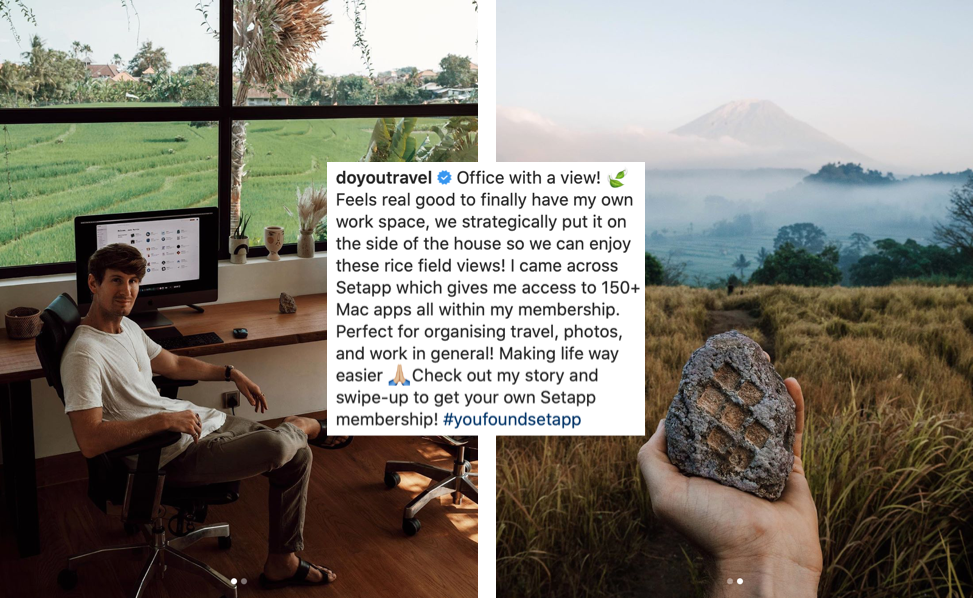
Sam Kolder sets himself in Hawaii among the hang gliders and sharks. Poke bowls and pig-pits. Kevin’s gotten leid there. This photo, however, was taken in what’s quickly becoming the wealthy tourist where-to, Saudi Arabia.
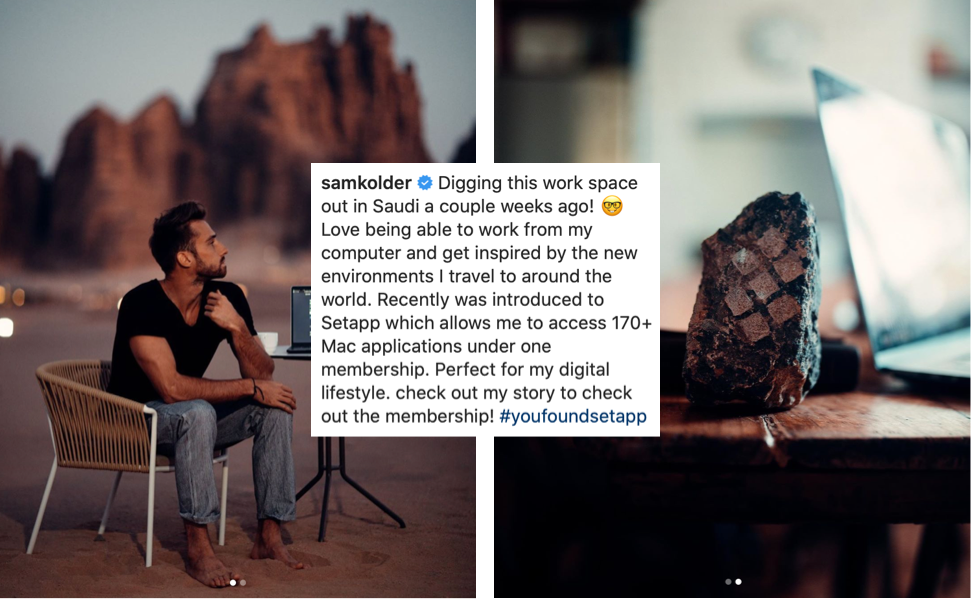
Not least, Slater Trout and his trapezii. A muscle-padded paddler and competition-winning surfer who shot some Setapp relic photographs in the States’ hot springs.
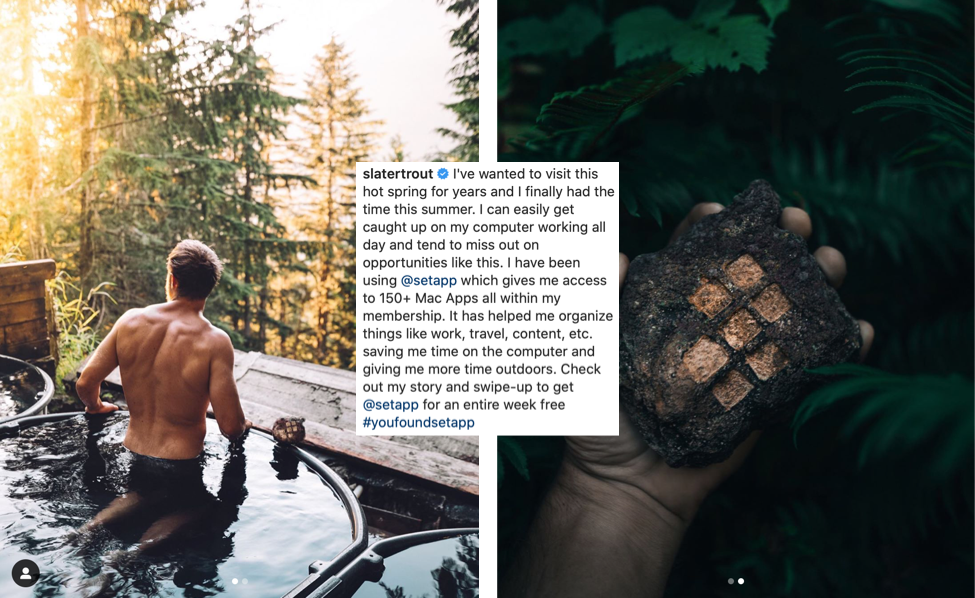
Jack set the style and the others took note. This kept the content consistent while still residing within each of the influencers’ own brand styles. Couldn’t have turned out more brilliant. The comments are where it really gets interesting. They’re the meat of the posts, what really matters. Mmm, Setapp meat.2
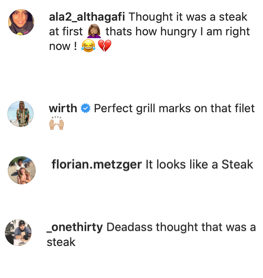
You’re not blind, my screenshots are rasterized, sorry about that. The steak reaction is hilarious. I love it. It’s this kind of response that sparks meme fuel. It also shows that the audience wasn’t offended by the advertising and could be playful right back.
Some sniffed out that it was an ad while others weren’t sure. This tinge of ambiguity is exactly what I was going for, but it’s also important that the brand message got across successfully, which it certainly seems to have.
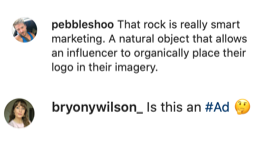
Others got pinched by the mystery of the relics, realizing that they must have been part of their celebrity’s adventurous lives. The rocks piqued brand interest, naturally.
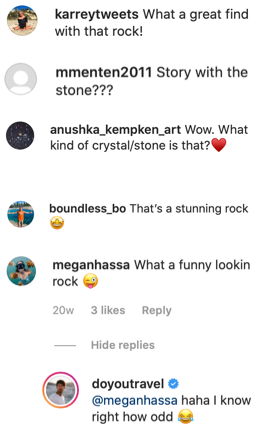
And then there were those who named Setapp directly, promulgating the product further in parallel with famous promoters. Influencer marketing done right. Done well? Well done. I prefer medium-rare.3
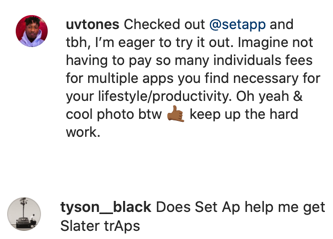
I did warn you that this would be an incomprehensive case study. That’s because I’ve left Setapp and no longer have access to their analytics. Unfortunately, I can’t demonstrate ROI or throw conversion rates at you. Fortunately, numbers can be dry to some and you won’t have to dodge heavy airborne statistics. I like to look at this lack of closure in a different light, because marketing campaigns are worth more than their charts.
Any PR person worth their nutgraf will tell you that brand associations go deep. Setapp has now been seen by millions of content creators through the eyes of their idols. Well, their idols’ idols. The rocks. And each of the posts are immortalized on their respective feeds due to a removal contract clause. The You found Setapp. stones turn yet another SaaS product into a dream-creation machine. A mini tool of tools for personal growth. And achieving your Dubai-dancing dreams are worth far more than Setapp’s monthly sterling setback.
Staying Hard
Couldn’t resist the subhead.
Manufactured value or produced product passion? This exercise in influencer marketing was not cheap, but to make money you’ve gotta have it. I’m still wrestling with the moral implications of selling a dream, as I don’t use most social media partially for this purpose. It’s dirty business. But if you believe in what you’re selling and rub the snake oil on yourself, you should be showing it off.
Setapp may form into something more useful down the line. For now, it saves creators and nomads a dime if they use a million apps and would save more subscribing to a rental service than paying for the tools directly. I enjoyed pondering ways to get it to people who’d find it practical, and really hope some folks found it through this campaign. For Setapp to stay hard as the world-traveling rocks that bear its symbol, it’ll have to innovate and listen to its caring member community.
It was difficult to bridge the physical world with the digital to promote a software product, but it was well worth it. Potential Setapp members could better understand that the service might provide more than the sum of its apps. When appealing to their audiences, good marketers must look deeper than demographics and where those traits intersect with product value. The rock campaign was risky for a reason. It bet on the idea that app users don’t want to be at their desks staring at a searing screen. They’ll use their apps as a means to make it, self-marooning somewhere in paradise.
A thanks to Ben, Jack, Sam, Slater, and Team Setapp.
I’m looking for my next project to pounce on. Email me or fly over to Twitter. For a little ding every now and then on my latest posts and ponderings, subscribe. And if you ever find one of the missing relics, make sure it’s not a horcrux before displaying on your own darling desk.
I could continue on this note, but this study’s focused on the campaign. To me, Setapp’s value is superficial and goes no deeper than a practical monetary equation, leading trial users to abandon ship when they realize they were only really using two or three apps they could buy outright. The bulk of the apps are fluff, and while the Setapp community recognizes this and suggests ways to improve the product, the product managers ignore customers, opting instead to develop small shiny things that contribute nothing truly valuable to the expensive overall experience.↩︎
Heh, don’t worry, I’m still vegetarian.↩︎
Ibid.↩︎